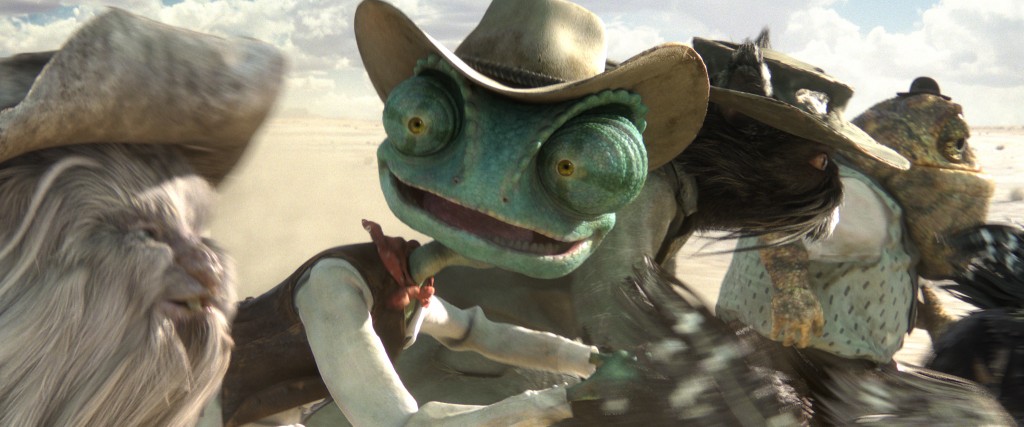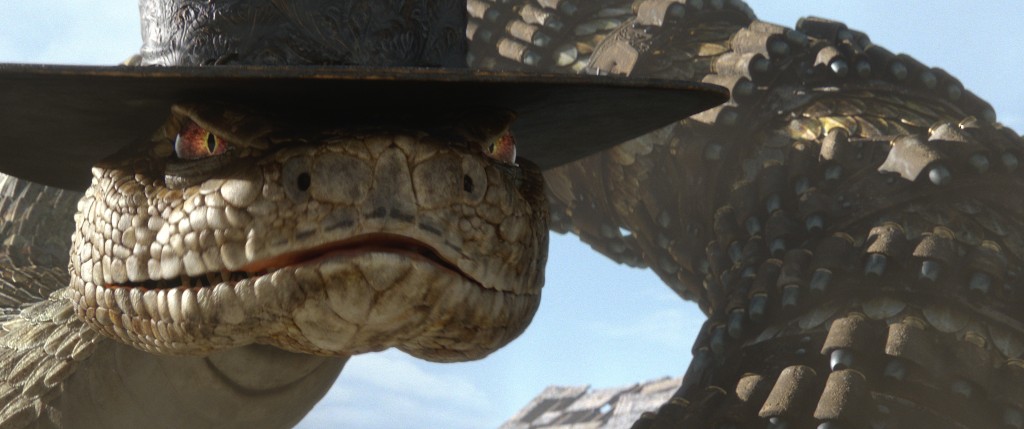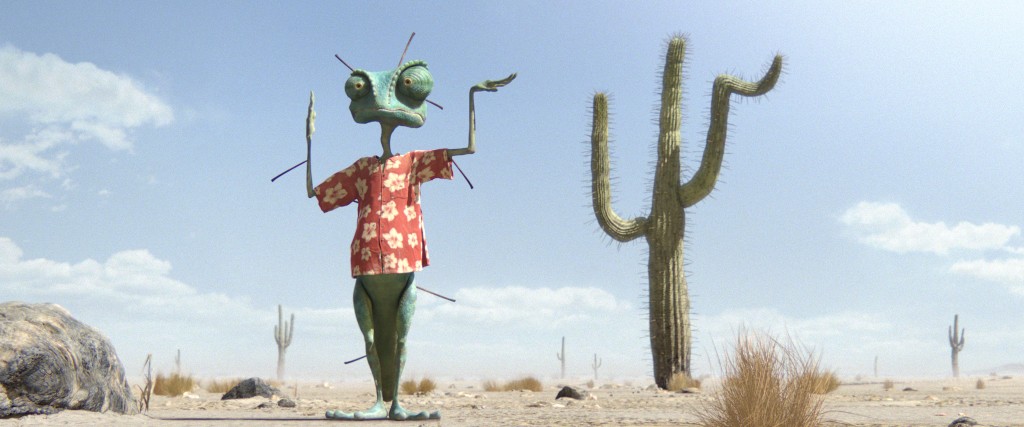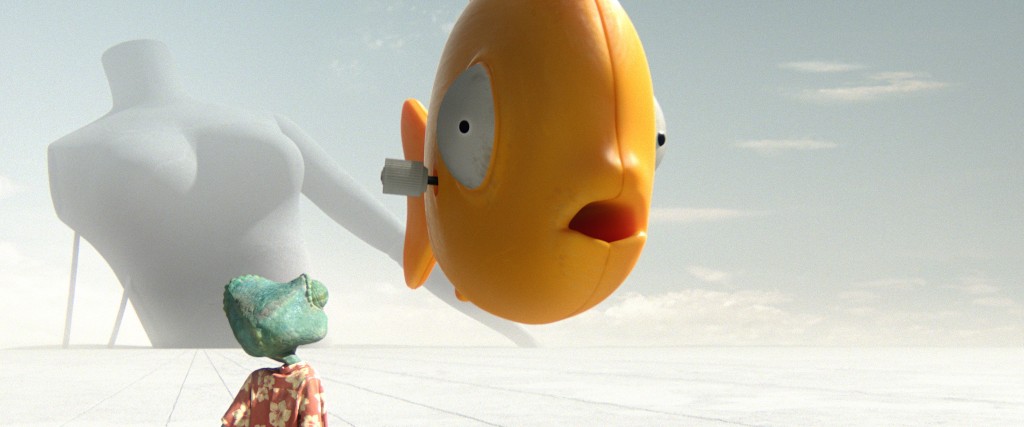Thu 3 Mar 2011
Ride ‘Em Rango!
Posted by Ethan under Film Review, NYC Film Critic
Comments Off on Ride ‘Em Rango!
Rango
Directed by Gore Verbinski
Screenplay by John Logan
Starring Johnny Depp, Isla Fisher, Ned Beatty, Bill Nighy
***1/2
Let’s get this out of the way upfront: I’m not sure that I’d call the new animated Western Rango a great kids movie, at least not for the under-5 set. I saw the film with my three-and-a-half year old son and I found myself occasionally cringing at its copious gunplay and casual attitude towards death. Rango also lacks the broad slapstick comedy that plays best with younger kids and the character designs noticeably avoid the unthreatening, plush-doll ready cuddliness that most contemporary cartoons employ. Indeed, several of the characters featured here are downright fearsome, most notably Rattlesnake Jake, an enormous serpent with glowing eyes, ultra-sharp fangs and a six-shooter for a rattle. When Jake slithered onscreen, I was certain my son would run screaming from the theater, but he took it in stride and, funnily enough, calls him one of his favorite characters. In fact, I should note that he seemed to really enjoy the movie overall, only growing a little antsy and uncomfortable during a few scenes. He’s also been talking about Rango non-stop since the screening, so it’s entirely possible that I was just being too oversensitive in the moment. Nevertheless, I’d hesitate to recommend the film to other parents of very young children lest those kids come home traumatized and unable to sleep for weeks afterwards due to Rattlesnake Jake-induced nightmares.
Okay, so Rango may not be a great kids movie. But it is a great movie, one of my favorites of this young year and among the most unique features I’ve seen from an American animation house in recent memory. It’s hard to believe that it’s a product of Nickelodeon Movies, the film arm of the ubiquitous kids channel that’s primarily produced big-screen versions of popular series like Rugrats, Jimmy Neutron and SpongeBob Squarepants. It’s even harder to believe that it sprang from the brain of Gore Verbinski, the guy best known for the messy, but diverting Pirates of the Caribbean adventure and its two awful sequels. As a live-action director, Verbinski has demonstrated a comfortable proficiency with technology, but not much in the way of an artistic eye. Prior to Rango, his most striking piece of direction was the surreal black-and-white video at the center of his otherwise conventional 2002 remake of the Japanese horror film The Ring. Working in animation appears to have unlocked his inner artist though, because Rango is, above all, a visually dynamic film filled with striking compositions, beautiful lighting (ace cinematographer Roger Deakins—the man responsible for True Grit’s beautiful Western landscapes—was a behind-the-scenes consultant on the production) and an inventive use of space within every frame.
It’s funny, as sophisticated as American animated films have grown within the past two decades, very rarely do either filmmakers (or critics for that matter) seem to take the time to think about the visual language of these movies. The tendency is to evaluate the images almost exclusively in terms of how they move the story along. A studio like Pixar, for example, is justly praised for its superb storytelling skills and the animators there often describe how every shot is intended to serve the narrative first and foremost. So even a lovely visuals-driven sequence like that famous opening montage in Up or the first thirty minutes of Wall-E are still designed as a way to advance the story. Rango is closer in spirit to Japanese anime, where the images aren’t necessarily always tethered to a grand overarching narrative. That’s not to imply that the film doesn’t have a story, mind you; Verbinski and screenwriter John Logan (The Aviator) have actually crafted a very clever tale that reveals itself in beautifully subtle ways. There’s not a lot of info dumping going on here—scenes where the characters exchange exposition-heavy dialogue explaining what exactly is going on. Instead, the story emerges from the title character’s interactions with the supporting cast as well as the strange sights and events he observes in the movie’s primary setting, the dusty, reptile-populated frontier town of Dirt.
In Hollywood pitch-speak, Rango is probably best described as The Good, The Bad and The Ugly meets Chinatown with a dash of Jim Jarmusch’s surrealistic Dead Man (which also starred Depp) thrown in for good measure. The movie opens in the glass cage that houses an oddball chameleon (voiced by Johnny Depp) who fancies himself a great thespian. As the frustrated actor choreographs his latest scene with the help of his cage companions—a headless Barbie doll and a wind-up toy fish—the car he’s being transported in swerves violently and his cage tumbles onto the asphalt of a desert highway, shattering into a dozen pieces. His home gone, he wanders the parched landscape until arriving in Dirt. Wandering into the local saloon in search of a much-needed drink of water, he feels all eyes turn towards him. One of the locals then asks for the stranger’s name and in a quick moment of improv, this lizard of many colors invents a new hue: Rango, adventurer and justice-dispenser.
You can say this for our reptilian hero—when he picks a role, he commits to it wholeheartedly. As Rango, he allows himself to be talked in to becoming Dirt’s sheriff and protecting the town’s rapidly dwindling water supply. (In a wonderful visual touch, we’re shown that the water is kept in a clear plastic water jug—the kind you normally see atop an office water dispenser—that’s locked away in a bank vault. The movie is filled with terrific details like this and the filmmakers never go out of their way to call attention to them.) When thieves make off with the last of the precious liquid, he organizes a posse to recover it. In the process, he stumbles upon a scheme concocted by the crafty mayor (Ned Beatty, channeling John Huston’s immortal Noah Cross) to divert water away from Dirt and towards his new venture—a reptile-sized version of Las Vegas.
Had Pixar or DreamWorks Animation produced Rango, the film would most likely have unfolded at a more rigorous clip, carefully alternating spectacular set-pieces with quiet moments of character building and/or comedy. Verbinski and Logan don’t program the proceedings so rigidly, instead allowing for numerous diversions from the main story, most notably Rango’s spectral encounter with the mythical “Spirit of the West,†who turns out to be the spitting image of Clint Eastwood’s iconic Man With No Name. (Justified’s Timothy Olyphant shows off a killer Eastwood impression in this very funny cameo role—if Hollywood ever attempts a motion-capture remake of one of Clint’s old spaghetti westerns, he’s got the job.) Some moviegoers may grow impatient with the film’s meandering nature and general strangeness, but many more—including kids, by the way—will probably be tickled by its flights of fancy. Additional kudos must go to the folks at the venerable effects company Industrial Light and Magic (making their debut as a production house for feature-length animated films) for their beautifully rendered computer animation, from the stunning desert backdrops to the memorable character design. Too many family-oriented animated features feel obligated to follow the same predictable rhythms, but Rango rides tall in the saddle at its own distinct pace.
Rango opens in theaters on Friday.
————————————————————————————————————————————————————————–
Also In Theaters:
Uncle Boonmee Who Can Recall His Past Lives
Written and Directed by Apichatpong Weerasethakul
Starring Thanapat Saisaymar, Sadka Kaewbuadee
***
It’s not easy to prepare someone for the experience of watching his or her first Apichatpong Weerasethakul film. I’ve only seen two of the Thai filmmaker’s movies myself—2004’s’s Tropical Malady and his latest effort, the Cannes-awards winning Uncle Boonmee Who Can Control His Past Lives—and both times I’ve found the viewing experience to be both enthralling and baffling. Enthralling because his movies are unlike anything else out there right now in the way they mix mysticism and realism and completely depart from a typical narrative structure. Baffling because they are so removed from current American cinematic conventions that one spends a lot of the movie (perhaps too much) trying to make logical sense of something that isn’t necessarily supposed to be logical at all. Personally, my big stumbling block with Weerasethakul has always been the way he directs his performers, most of whom are non-actors. He doesn’t seem all that interested in tasking them to create fully-rounded characters; in individual scenes, their delivery and facial expressions almost run counter to the material they’ve been given to play. For example, the title character in Uncle Boonmee is a dying man who is visited by various spirits—including his dead wife and their lost son, who wandered into the jungle and re-emerged as a monkey—as the end approaches and also revisits some of his past lives. But Boonmee doesn’t express much in the way of surprise or emotion as these mystical events occur; he merely goes on with what little he has left of his life. At the same time though, the movie’s casual approach to blending fantasy and reality is one of its chief selling points. This isn’t aggressive, in-your-face fantasy—it’s relaxed and almost comically strange. Perhaps the best way to experience Uncle Boonmee or really any Weerasethakul film is to let his odd vision of the world sweep over you and not sweat the details too much.
I Saw The Devil
Directed by Kim Jee-woon
Written by Park Hoon-jung
Starring Lee Byung-hun, Choi Min-sik
***
Overlong at two-and-a-half hours, this South Korean revenge thriller still delivers some memorable (and memorably gory) set-pieces and an emotionally-charged premise. After his pregnant fiancée becomes the latest victim of a vicious serial killer, a government agent (Lee Byung-hun) goes to extreme lengths to find the murderer. Sixty minutes in to the movie, he comes face to face with his prey (Choi Min-sik, star of the cult Korean hit Oldboy) and administers his own brutal beating…but walks away leaving the man alive. See, in his grief-addled state he’s decided that the most appropriate course of vengeance would be to shadow the killer for days, appearing at unexpected times to dole out more punishment before finally ending his life for good. What he doesn’t count on, of course, is this guy’s resilience and wiliness, traits fueled by his general insanity. Their protracted cat-and-mouse game results in big casualties on both sides and when the agent is finally on the cusp of achieving his revenge, it’s highly unlikely that he’ll walk away satisfied. Director Kim Jee-woon wears his influences on his sleeve—there’s a little David Fincher here, some Park Chan-wook there and even a bit of Michael Mann in the tense face-offs between cop and killer—but I Saw The Devil isn’t just an extended homage to other movies. Kim avoids the wild plot twists and bizarre humor of Park’s famous “Revenge Trilogy†(of which Oldboy was the middle chapter) in favor of a straightforward and unrelentingly grim march towards an apocalyptic finale. Personally, I prefer the gonzo qualities of Park’s peculiar take on revenge, but this film is admirable in the methodical way it breaks down the righteousness of the hero’s cause. Plenty of movies have taken their good guys up to and even past the line of sanity, but few have left them so broken.
The Human Resources Manager
Directed by Eran Riklis
Screenplay by Noah Stollman
Starring Mark Ivanir, Reymond Amsalem, Gila Almagor
**1/2
Israeli director Eran Riklis’ follow-up to his acclaimed 2008 drama Lemon Tree is really two movies in one and I liked one movie far more than the other. In its first thirty minutes, The Human Resources Manager is a compelling bureaucratic procedural that follows the hangdog HR guy (Mark Ivanir) at a major Jerusalem factory as he pieces together the final hours of one of his company’s employees, who was recently killed in a bus bombing. Turns out, the victim was a Romanian immigrant and, in order to save face after being accused of negligence, the company agrees to transport her body back to her native country. The manager is tasked with making the trip to Romania to ensure she’s properly buried, but once there he can’t find anyone able to sign the death certificate, as she’s divorced from her husband and their only child—a delinquent in training—is a minor. The only immediate family member able to claim the body is her elderly mother, who lives in a remote village deep in the mountains. A conveniently timed storm makes flying there impossible, so he loads the coffin into a van and sets off down the country’s highways, back roads and winding mountain passes, bringing along her son, a guide and an annoying Israeli journalist for company. At this point, the film becomes a gentle road comedy in which personalities clash, lessons are learned and everyone arrives at their final destination just a little bit happier. It’s overly familiar stuff and, apart from the setting and the scenery (the exteriors of the Romanian countryside have a certain desolate beauty), there’s not a lot here that makes the proceedings more interesting. I’d still be interested in seeing the continuation of the procedural version of the story though.
Dear Lemon Lima
Written and Directed by Suzi Yoonessi
Starring Savanah Wiltfong, Shayne Topp, Melissa Leo
**
In small-town Alaska, a dorky teenage girl with an active fantasy life and a doodle-filled notebook adjusts to life as the school outcast and pines for one of the school’s most popular guys. No, this isn’t Napoleona Dynamite, although the influence of that earlier film is keenly felt throughout both in the movie’s whimsical (though far less caustic) sense of humor and episodic structure. The title refers to our heroine Vanessa’s journal entries, which are addressed to an imaginary pen pal that’s been part of her life since childhood. Over the course of the movie, Vanessa (played by newcomer Savanah Wiltfong) is forced to do some major-league growing up starting when her boyfriend Philip (Shayne Topp) breaks up with her before entering a ritzy private high school and becoming the aforementioned BMOC. Thanks to a last-minute scholarship, she’s able to attend the same school, but is shunned by her old flame and seeks refuse with a motley crew of fellow freaks and geeks. The plot, such as it is, kicks into gear with the announcement of the annual Snowstorm Survivor competition in which teams face off in a series of different physical challenges. Vanessa rallies her troops into entering the event and they go on to show the school what a few good geeks are capable of. Writer/director Suzi Yoonessi stages a handful of sweet moments and coaxes likable, mostly non-cloying performances from her young cast, but much like its main character Dear Lemon Lima is a little too self-consciously precious. It’s a coming-of-age story where the heroine doesn’t convincingly grow up.





No Responses to “ Ride ‘Em Rango! ”
Sorry, comments for this entry are closed at this time.